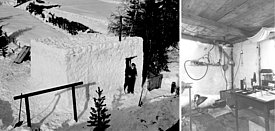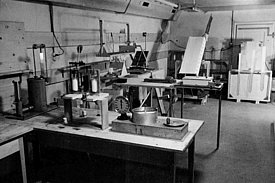
Sites and facilities for snow and ice ¶
It all began in 1935 in an igloo. Today, the snow researchers at the SLF work with radar measurements and computer tomography. But depending on the situation, they still use magnifying glasses and grids – just like 80 years ago.
When researchers carried out the first systematic snow measurements in Davos in 1935, they worked in a laboratory building made of snow (Fig. 1). As not only the experiments but also the whole building threatened to melt away during heat dips, the following winter they built a wooden research site on the Weissfluhjoch and set up an experimental field. They worked there until 1943, when the SLF was able to inaugurate its new institute building on the Weissfluhjoch. The scientific discipline of snow and avalanche research required not only premises but also its own methodology and measuring instruments. In the early years, the scientists therefore developed various measuring instruments such as the ram probe, shear apparatus or a device for determining the air permeability of the snow. Some of these instruments are still in use today, partly with refined technology, of course. Since the first cold laboratories were put into operation in 1944, experiments with snow can be carried out all year round.
Experimental facilities today
In the meantime, we operate several experimental sites and laboratories in the Davos area, but also in the Valais. In addition to snow mechanics and avalanche formation, the optical properties of snow or atmospheric processes interacting with the snow cover are studied there, for example. We conduct research in wind tunnels, investigate the sliding properties of ski bases in the snow sports laboratory and can scan snow during its metamorphosis with the microcomputer tomograph.
Together with the cantons, we operate a network of automatic wind and snow measuring stations (IMIS) that provides us with wind and snow data from higher altitudes. Together with the daily measurements and observations of more than 200 observers, these data are an important basis for the daily avalanche bulletin. And the daily snow measurement at the Weissfluhjoch test field is still carried out today – among other things with a magnifying glass and grid, just like 80 years ago.







